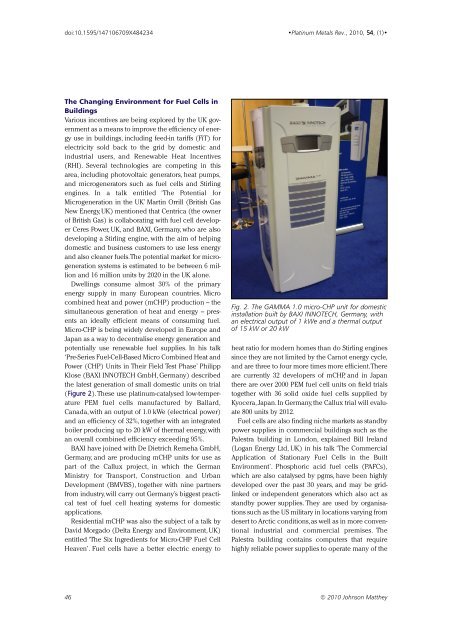Download Issue PDF - Platinum Metals Review
Download Issue PDF - Platinum Metals Review
Download Issue PDF - Platinum Metals Review
Create successful ePaper yourself
Turn your PDF publications into a flip-book with our unique Google optimized e-Paper software.
doi:10.1595/147106709X484234<br />
•<strong>Platinum</strong> <strong>Metals</strong> Rev., 2010, 54, (1)•<br />
The Changing Environment for Fuel Cells in<br />
Buildings<br />
Various incentives are being explored by the UK government<br />
as a means to improve the efficiency of energy<br />
use in buildings, including feed-in tariffs (FiT) for<br />
electricity sold back to the grid by domestic and<br />
industrial users, and Renewable Heat Incentives<br />
(RHI). Several technologies are competing in this<br />
area, including photovoltaic generators, heat pumps,<br />
and microgenerators such as fuel cells and Stirling<br />
engines. In a talk entitled ‘The Potential for<br />
Microgeneration in the UK’ Martin Orrill (British Gas<br />
New Energy, UK) mentioned that Centrica (the owner<br />
of British Gas) is collaborating with fuel cell developer<br />
Ceres Power, UK, and BAXI, Germany, who are also<br />
developing a Stirling engine, with the aim of helping<br />
domestic and business customers to use less energy<br />
and also cleaner fuels.The potential market for microgeneration<br />
systems is estimated to be between 6 million<br />
and 16 million units by 2020 in the UK alone.<br />
Dwellings consume almost 30% of the primary<br />
energy supply in many European countries. Micro<br />
combined heat and power (mCHP) production – the<br />
simultaneous generation of heat and energy – presents<br />
an ideally efficient means of consuming fuel.<br />
Micro-CHP is being widely developed in Europe and<br />
Japan as a way to decentralise energy generation and<br />
potentially use renewable fuel supplies. In his talk<br />
‘Pre-Series Fuel-Cell-Based Micro Combined Heat and<br />
Power (CHP) Units in Their Field Test Phase’ Philipp<br />
Klose (BAXI INNOTECH GmbH, Germany) described<br />
the latest generation of small domestic units on trial<br />
(Figure 2).These use platinum-catalysed low-temperature<br />
PEM fuel cells manufactured by Ballard,<br />
Canada, with an output of 1.0 kWe (electrical power)<br />
and an efficiency of 32%, together with an integrated<br />
boiler producing up to 20 kW of thermal energy, with<br />
an overall combined efficiency exceeding 95%.<br />
BAXI have joined with De Dietrich Remeha GmbH,<br />
Germany, and are producing mCHP units for use as<br />
part of the Callux project, in which the German<br />
Ministry for Transport, Construction and Urban<br />
Development (BMVBS), together with nine partners<br />
from industry,will carry out Germany’s biggest practical<br />
test of fuel cell heating systems for domestic<br />
applications.<br />
Residential mCHP was also the subject of a talk by<br />
David Morgado (Delta Energy and Environment, UK)<br />
entitled ‘The Six Ingredients for Micro-CHP Fuel Cell<br />
Heaven’. Fuel cells have a better electric energy to<br />
Fig. 2. The GAMMA 1.0 micro-CHP unit for domestic<br />
installation built by BAXI INNOTECH, Germany, with<br />
an electrical output of 1 kWe and a thermal output<br />
of 15 kW or 20 kW<br />
heat ratio for modern homes than do Stirling engines<br />
since they are not limited by the Carnot energy cycle,<br />
and are three to four more times more efficient.There<br />
are currently 32 developers of mCHP, and in Japan<br />
there are over 2000 PEM fuel cell units on field trials<br />
together with 36 solid oxide fuel cells supplied by<br />
Kyocera,Japan.In Germany,the Callux trial will evaluate<br />
800 units by 2012.<br />
Fuel cells are also finding niche markets as standby<br />
power supplies in commercial buildings such as the<br />
Palestra building in London, explained Bill Ireland<br />
(Logan Energy Ltd, UK) in his talk ‘The Commercial<br />
Application of Stationary Fuel Cells in the Built<br />
Environment’. Phosphoric acid fuel cells (PAFCs),<br />
which are also catalysed by pgms, have been highly<br />
developed over the past 30 years, and may be gridlinked<br />
or independent generators which also act as<br />
standby power supplies. They are used by organisations<br />
such as the US military in locations varying from<br />
desert to Arctic conditions,as well as in more conventional<br />
industrial and commercial premises. The<br />
Palestra building contains computers that require<br />
highly reliable power supplies to operate many of the<br />
46 © 2010 Johnson Matthey
















